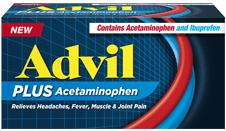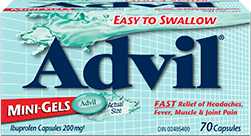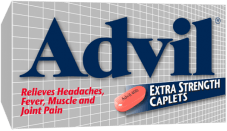Migraine Symptom Checklist
Get our migraine symptom checklist to identify and try to prevent future migraines.

Migraine attacks can last 4 to 72 hours, however, the symptoms and warning signs can start days before. And then, there are the after affects.
Because migraines can have a broad spectrum of severity, attacks can differ between people, and even from attack to attack. The symptoms can vary widely as well. Because of this, misdiagnosis can be common – at least half of all migraine sufferers think they have sinus or tension headaches, not migraines.
Understanding the symptoms and their progression can help you better manage your migraines and help you get back to being you.
Everyone experiences migraines differently
Is it a migraine?
POUND – an easy way to remember the features of a migraine.
P is for pulsating pain
O for one-day duration of severe untreated attacks
U for unilateral (one-sided) pain
N for nausea and vomiting
D for disabling intensity
The Stages of a Migraine
Prodrome
Up to 77% of people with migraines experience the prodrome phase, or pre-headache, which signals the oncoming of a migraine. Symptoms can begin a few hours to a few days before, and they may not happen before every attack.
This is the time to avoid triggers, practicing meditation and other relaxing exercises to help get ahead of the pain, or maybe even ward off the attack.
Feel a migraine coming on? Avoid triggers and practice relaxation techniques.
Aura
About a quarter of the people suffering from migraines also experience aura, and like the prodrome, it doesn’t happen for every attack. As a symptom of the nervous system, aura is often marked by visual disturbances like vision loss, patterns or light flashes, and numbness or tingling on one side of the body. Some people experience the symptoms of aura without getting a headache, and believe they are having a stroke.
This phase typically precedes the headache so can also be a warning of an impending attack. This can be a cue to take medication like Advil® Extra Strength Liqui-Gels® and avoid triggers.
Attack
As early as possible in this onset stage is when medication is most often recommended. Some people also benefit from taking medication during the aura phase. Medication is not recommended during the prodromal phase to balance against the risk of medication overuse.
This stage is where the severity really sets in, with pain on one or both sides of the head and even shifting around to the other side.
But pain is just one part of this phase – you can also experience nausea, difficulty sleeping, or sensitivity to light, sound and smells. The aura symptoms may even continue into this phase. Every day activities can become difficult and movement can aggravate the attack.
An attack can last up to 72 hours if untreated.
Postdrome
Also called the migraine hangover, this is actually the last phase of the migraine, and can be just as debilitating. Some people are left drained, while others may feel elated.
This is the time to focus on yourself and your well-being. Your body has just been under attack, and you need to help it recover. Drink lots of water, eat beneficial foods, rest, and do calming activities like yoga, meditation, and other relaxing exercises. Avoid triggers and stress and prioritize self-care.
Beneficial Foods
Nutrient-rich foods can help the migraine hangover, such as whole grains like breads and pastas, as well as lean sources of protein, like chicken and fish. However, skip the seasoning and spice. Bland foods are best when fighting the migraine hangover, because they help combat nausea.
Your body has just been under attack. You need to help it recover.
Migraine Symptom Checklist
Prodrome
Timing
A few hours to a few days
Symptoms
- Mood changes
- Become excitable
- Irritability
- Depression
- Yawning
- Fatigue
- Insomnia
- Sensitivity to light and/ or sound
- Unusual smell or taste sensation
- Trouble concentrating
- Difficulty speaking
- Muscle tension (neck & shoulders)
- Food cravings
- Nausea
- Increased need to urinate
- Constipation or diarrhea
Aura
Timing
5-60 minutes
Symptoms
- Visual appearance of geometric patterns
- Wavy lines or dots
- Flashing or shimmering lights
- Blind spots
- Blurry vision
- Temporary vision loss
- Numbness or tingling in arms and face
- Ringing in the ears
- Changes to the way things taste, smell, or feel
Attack
Timing
4-72 hours
Symptoms
- Throbbing
- Drilling
- Sharp icepick-like sensation to the head
- Burning
- Nausea
- Vomiting
- Giddiness
- Insomnia
- Nasal Congestion
- Anxiety
- Depressed mood
- Heightened sensitivity to lights, sounds and smells
- Neck stiffness and pain
Postdrome
Timing
24-48 hours
Symptoms
- Inability to concentrate
- Lack of comprehension
- Fatigue
- Depressed mood
- Euphoric mood
For more information about migraines, go to the migraine section on our website.
Sources:
- Hard Facts on Tough Migraines. Hard Facts on Tough Migraines, Advil®. https://www.advil.ca/sites/default/files/adv-12002_migraine_tearsheet_en_04-30-12_0_1.pdf
- Harvard Health Publishing. “Headache: When to Worry, What to Do.” Harvard Health, Harvard Health, www.health.harvard.edu/pain/headache-when-to-worry-what-to-do.
- Mayo Clinic Staff. “Migraine.” Mayo Clinic, Mayo Foundation for Medical Education and Research, 31 May 2019, www.mayoclinic.org/diseases-conditions/migraine-headache/symptoms-causes/syc-20360201.
- “Migraines Pictures: What Aura Looks Like, Tracking Triggers, and More.” WebMD, WebMD, www.webmd.com/migraines-headaches/ss/slideshow-migraine-overview. Reviewed by Stephen D. Silberstein, MD on August 09, 2017
- “More than ‘Just a Headache.’” The Migraine Trust, The Migraine Trust, www.migrainetrust.org/about-migraine/migraine-what-is-it/more-than-just-a-headache/.
- “Symptoms and Stages.” The Migraine Trust, The Migraine Trust, www.migrainetrust.org/about-migraine/migraine-what-is-it/symptoms-and-stages/.
- “The Timeline of a Migraine Attack.” American Migraine Foundation, American Migraine Foundation, 18 Jan. 2018, www.americanmigrainefoundation.org/resource-library/timeline-migraine-attack/.
- “What Is Migraine?” The Ontario Migraine Clinic. What Is a Migraine., The Ontario Migraine Clinic, www.migraineclinic.ca/migraines.html.
- “The 10 Best Nutrient-Rich Foods That Help Migraine” MigraineAgain, David Rearden, April 25, 2019 https://migraineagain.com/10-foods-that-help-migraine/
- “Migraine Stages & Symptoms: Prodromal, Aura, Attack, Postdromal.” WebMD, WebMD, www.webmd.com/migraines-headaches/guide/migraine-phases#1. Reviewed by Melinda Ratini, DO, MS on April 27, 2018
- Kelman, L. (2004). “The premonitory symptoms (prodrome): a tertiary carestudy of 893 migraineurs.” Headache: The Journal of Head and Face Pain, 44(9), 865-872.
- Laurell, K., Artto, V., Bendtsen, L., Hagen, K., Häggström, J., Linde, M., ... & Kallela, M. (2016). “Premonitory symptoms in migraine: a cross-sectional study in 2714 persons.” Cephalalgia, 36(10), 951-959.
- “Headache Classification Committee of the International Headache Society. The international classification of headache disorders, 3rd ed.” Cephalalgia. 2013. 33(9):629–808.
- Cutrer FM, Bajwa ZH. “Pathophysiology, clinical manifestations, and diagnosis of migraine in adults.” UpToDate 2015. 20:1–18.
- Worthington, I., Pringsheim, T., Gawel, M. J., Gladstone, J., Cooper, P., Dilli, E., ... & Becker, W. J. (2013). “Canadian Headache Society Guideline: acute drug therapy for migraine headache.” Canadian Journal of Neurological Sciences, 40(S3), S1-S3.
Be sure this product is right for you. Always read and follow the directions on the label. This information is provided for educational purposes only and should not be used as a substitute for professional medical advice, diagnosis, or treatment. Speak to your healthcare professional before making any changes to your lifestyle or before beginning or discontinuing any course of treatment. Never disregard professional medical advice or delay in seeking it because of something you have read on this site.




